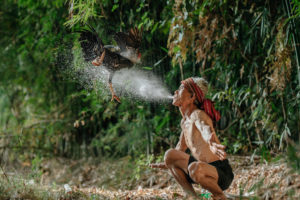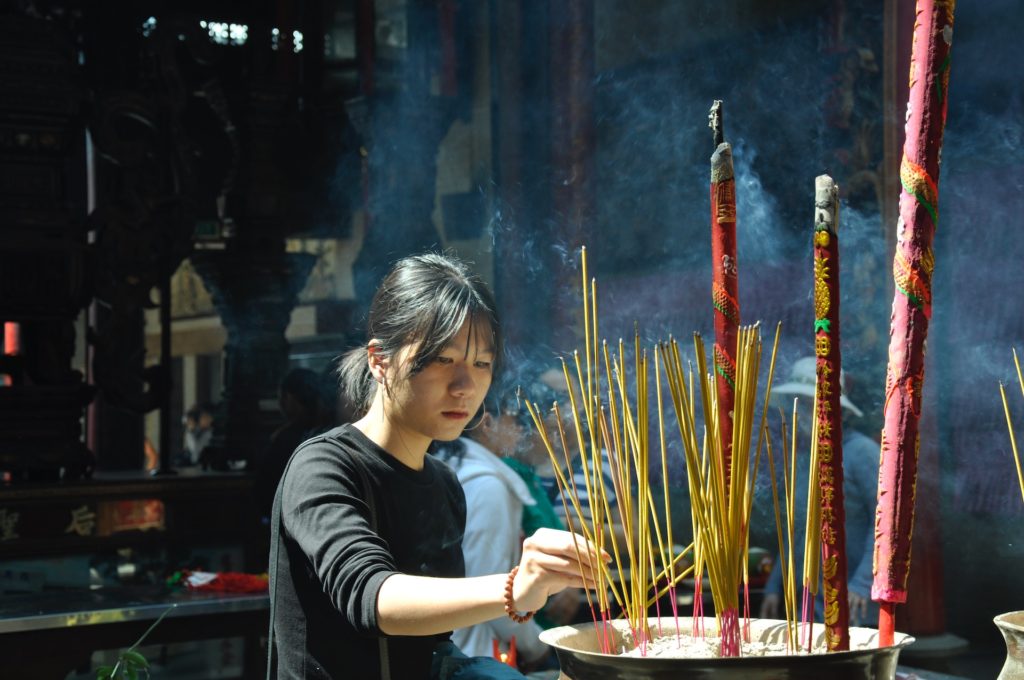Rituals

It encompasses several other traits of orality. They act out and convey collective meaning to successive life events (weddings, graduations).
Story: Why Would You Do This to Yourself?
Michael: This tradition sounds crazy to me.
Suryo: It might seem strange to you, but it’s a part of our culture.
Michael: But what’s the point of enduring that kind of pain?
Suryo: The pain is a test of our strength and endurance. And more importantly, it’s a symbol of our commitment to our community and our values.
Michael: I am trying to wrap my head around this. But what if you don’t go through with it? Will you be seen as less of a man?
Suryo: It’s not about being seen as less of a man but more about missing out on an important part of our culture. It’s a rite of passage that marks our transition into adulthood and is a crucial step in our personal growth.
Michael (shaking his head): I don’t think I could ever do something like that. It sounds too painful.
Suryo: It’s not for everyone. But for those who participate, it’s a way to connect with our ancestors and heritage. It’s a way to show our respect and honor for those who came before us.
Michael: I will cross my fingers for you. I am glad that our transition into adulthood means moving out of our parents and living independently!

Examples from the Bible
- God used the rituals familiar to those He called (Abraham and Israel, the people of God) to reveal His will and plans to them. Rituals are a kind of legally binding contract (Genesis 15)
- Rituals such as circumcision were established for the Jews so that people could learn and remember God’s will and work (Genesis 17).
- The Passover was a ritual that facilitated generational memory as it was celebrated annually with all its symbols (Exodus 13:14-16).

- In Mark 7:1-23, Jesus redefines washing from washing hands (form) to inner cleanliness (meaning). In verse 9, he even calls out that people do the ritual (tradition/form) without caring for God’s commandment (meaning).
- Baptism is a ritual symbolizing salvation through Jesus (1 Peter 3:21). Jesus redefined the Jewish ritual of Passover (Exodus 12) with a different meaning for the church (Matthew 26:26-29).
Real-life examples
- At Easter time, the whole community comes out to observe processions related to the passion of Jesus. It happens on Good Friday at 10:00 AM. It extends into the evening with “floats” of the Saints followed by “the faithful” in adoration. The whole family is involved, marking a transition in our calendar year.
- At Easter time, we hide candy-filled plastic eggs and let the children find them and eat the candy over the following days and weeks. There is no set place or time. It could be inside a house or outdoors, and the activity is just fun for our family to watch with no real meaning.
- Everyone is expected to attend when we celebrate our “becoming a man” (or woman) ritual. Being absent would be considered shameful and an insult to the family.
- When we celebrate a birthday, having all the family together is lovely, but that rarely happens. It’s understood that other things might have to take priority over the rite of passage.
Relevance

Rituals are loaded with meaning and tell a people’s story. They are a memorable and emotion-loaded way of how groups pass on values and cultural norms. They are often used as rites of passage that put the participant into a new state, give identity, or associate with a group.
All cultures have rituals marking important points in life (birth, adulthood, marriage, death). Washing rituals are found in most religions and have a spiritual meaning.
Rites of passage define one’s status (a wedding brings a couple into a new social position) or association (baptism is a sign of changed identity in many churches – now you are one of us) in society.
Rituals also strengthen a group’s identity (the Lord’s Supper is taken only by the Church’s members). They are closely linked to the trait of orality of identity. They are often narrative in action that make use of artistic expressions.
Rituals play a central role in a people’s worldview and must therefore be explored to bring about transformation. They must be a part of what Charles Kraft calls Dynamic Equivalent1 and Paul Hiebert Critical Contextualization.2
Orality preference continuum
Let’s see how HOR and LOR cultures look on both ends of a continuum.
For HOR people, rituals are essential. They are performed as transformative events and defining aspects of a community.
Rituals mostly lost their original meaning on the LOR end of the continuum. They are still performed but sometimes not even recognized as such.
Most people fall between both extremes, as seen in the examples below.
| Very high | High | Low | Very low |
|---|---|---|---|
| Weddings should be attended by everyone in our “community.” To not attend would be an insult. | Weddings should be attended, and someone would only not show up if prevented. | Friends and family are invited and expected to attend a wedding but may have valid excuses not to show up. | Attending weddings is totally optional for friends and relatives. |
| We have clearly defined rites of passage for “manhood” or “womanhood”? | Rites of passage (boy to man or girl to woman) are well-known but not always practiced. | Our people recognize that we move from girl to woman, but there is no public recognition. | No particular rite or ritual defines moving from boy to man or girl to woman. |
| Everyone takes part in the public celebration. | Mostly relatives and friends would celebrate together. | A family tradition of “man or woman” would be celebrated – 18th/21st birthday. | There is no one type of rite/ritual for becoming a man or woman. Each group is different. |
| Rituals are embedded in mythology and folklore. | Stories about the beginning of this ritual are told. | Not all people know the meaning and origin of the ritual. | There is little meaning in rituals; sometimes, they are not perceived as such. |
What has been discovered?
Rituals connect communities at deep spiritual and emotional levels.3
A ritual creates a space for interaction and building relationships.4
Without understanding the rituals of culture, you will never fully understand the culture.5
Rituals mark events where people “transform” from one state to another. I.E., from child to adult or from single to married. This is accompanied by new status and responsibilities.6
Rituals possess power in the community.7 They move whole communities from one state to another within the framework of festivals and even seasons of the year.
Additional resources
- Discover more about Rituals through our training materials at Orality.Academy!
- Listen to this webinar with Jay Moon about Oral Discipleship.
- Passing the Bullet Ant Test is a requirement for these young people to become adults.
- Moon, W. Jay. 2013. “Using Rituals to Disciple Oral Learners: Part 1.” Orality Jornal 2 (1): 43–63.
- Don Richardson’s Peace Child tells the story of a ritual transforming a cannibalistic community.
- Charles H. Kraft, “Dynamic Equivalence Churches,” Missiology: An International Review 1, no. 1 (January 1973): 39–57. ↩︎
- Paul G. Hiebert, “Critical Contextualization,” Missiology: An International Review XXII, no. 3 (1984): 287–96. ↩︎
- Moon, W. Jay. “Rituals and symbols in community development.” Missiology 40, no. 2 (2012): 141-152. ↩︎
- Daniel Z. Kadar, Relational Rituals and Communication (London: Palgrave Macmillan) 2013. ↩︎
- Maggay, Melba Padilla. The Gospel in Culture: Contextualization Issues through Asian Eyes. OMF Literature Incorporated, 2013.
Maggay, Melba Padilla. Transforming society. PhilAm Books, 1996. ↩︎ - Turner, Victor. Betwixt and Between: The Liminial Period in Rites de Passage. Symposium on New Approaches to the Study of Religion, 1999.
Moon, W. Jay. “Using Rituals to Disciple Oral Learners: Part 1.” Orality Journal 2, no. 1 (2013): 43–63. ↩︎ - Turner, Victor. “Liminal to liminoid, in play, flow, and ritual: An essay in comparative symbology.” Rice Institute Pamphlet-Rice University Studies 60, no. 3 (1974). ↩︎
